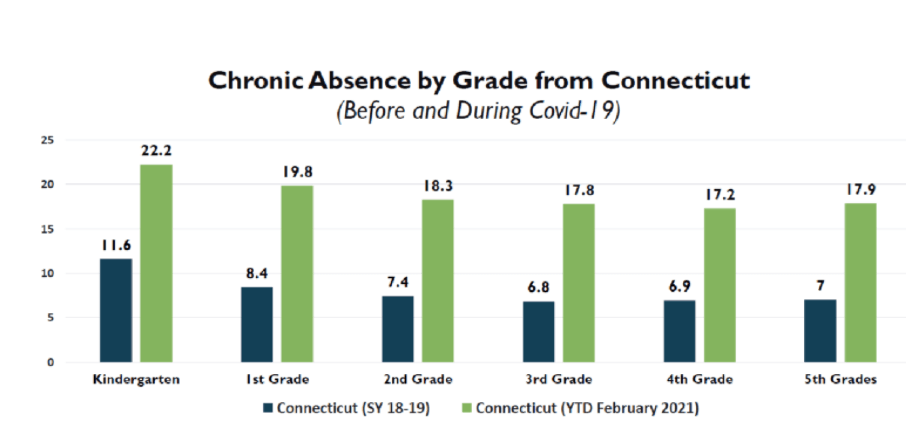Join us on Tuesday, April 27th, at the Campaign for Grade Level Reading’s (CGLR) webinar, co-sponsored by EdWeek, The Fall K-3 Classroom: What the Data Imply about Composition, Challenges and Opportunities. Learn more and register with EdWeek here.
New data provided by Curriculum Associates will shed insight into how the make-up of classrooms will change as a result of what CGLR is calling the “Covid-19 slide-turned-avalanche.” Their analysis is sobering, and it reveals that teachers will need to respond to a wider than ever range of academic experiences among their students.
Attendance Works will offer data suggesting that early grade classrooms are likely to experience higher than normal levels of churn, which can affect learning for the entire classroom, including students who are not chronically absent.(See this research by Michael Gottfried.)
“Enrollment hesitancy” among families is likely to result in some students, especially those living in communities that have experienced the more significant impacts from the pandemic, delaying participation in in-person classrooms. Families who have experienced more illness and death from Covid-19, and also distrust public health and educational systems, are understandably reluctant to send their students to school without strong assurances of health and safety.
At the same time, schools are likely to experience higher levels of chronic absence in the early grades than ever before. Even in a more typical school year, it takes a while for families with young students to get used to a new environment and establish a regular routine of showing up to school. It takes time to arrange daily transportation and back up support so children can attend class even when families face challenges. These adjustments will be even harder this year when so many students have been out of the routine of in-person school for as much as 18 months.
Prior to the pandemic, one out of 10 kindergarten and 1st grade students were chronically absent nationwide; those levels could have been double or triple in low-income communities. Data from Connecticut, the first state to release chronic absence data for the 2020-21 school year, shows dramatic increases in absences in the early grades when comparing the current situation to the 2018-19 school year. (See image below.) As in the past, chronic absence is highest in kindergartners. Unlike the year prior to the pandemic, however, the number of students missing 10% or more of school days in 1st – 3rd grade is not decreasing but is remaining elevated.
This data is an indication of what could happen nationwide next year. Connecticut pays close attention to data accuracy and has maintained high levels of in-person instruction.
Left unaddressed, high rates of chronic absence predict adverse consequences for learning. Chronically absent kindergartners are less likely to read on grade level, more likely to continue to be chronically absent and more likely to be retained. The gaps grow over time.
Students who live in poverty suffer the most. They are more likely to experience systemic attendance barriers (including inadequate access to quality health care, unreliable transportation and unstable housing) that are hard to resolve and can last multiple years. And families living in low-income communities are less likely to have resources at home to make up for lost learning time in the classroom.
Chronic absence is also a leading indicator and cause of educational inequity. Institutional biases and racism contribute to the disproportionately high levels of chronic absence among Black students as well as Native American, Pacific Islander and Latino students.
All of this has implications for how schools, districts and communities can support the youngest students and their families in the coming school year. The early data demonstrate the even more urgent need for:
- Enhanced attention to school climate.
- Continuously monitoring attendance and chronic absence to determine which students/families/classrooms or schools need even more outreach and possibly support, and to provide quick feedback about whether what we have put is working.
- Engaging in positive problem-solving not punitive action.
- Establishing authentic partnerships between teachers, parents and caregivers – the people that Jessie Woolley Wilson calls the “learning guardians” for kids.
We applaud the CGLR for its leadership in showcasing data that helps us strategically plan for the return to school in fall for our youngest students. This first webinar launches a series of conversations with pioneering thought leaders about the overall well-being of young children and the challenges and opportunities now facing students, teachers, school leaders and school districts. Register for the webinar.
To learn more about creating a framework for strengthening engagement with families and students, especially with those who have lost out on significant instructional opportunities during the pandemic, check out our new toolkit, Pathways to Engagement: Covid-19 Recovery Through Attendance. The toolkit offers engagement and attendance tools and strategies for all modes of instruction.
